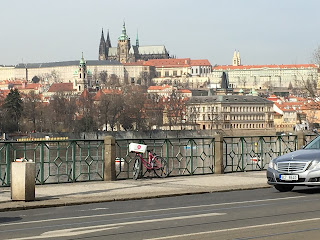The Castle on the Hill
The history of this largest ancient castle in the world goes back to the year 870. It is so expansive that it might be called a walled city. The current president of the Czech Republic still has his administrative offices in the castle, despite that fact that 1.8 million people visit this tourist attraction annually.
 |
| President's administrative offices |
Lobkowicz Palace is the only privately owned property within the castle walls. Today it is an art gallery and museum of the history of the Lobkowicz family over the last four centuries. We thought this was the most interesting part of the castle.
 |
| St. George's |
 St. George's Basilica is on the east end of the castle. It is no longer used for worship purposes.
St. George's Basilica is on the east end of the castle. It is no longer used for worship purposes.This church has a very unique architecture in that it has two altars - an upper one and a lower one. The stairs in the photo lead to the upper one, and the lower altar can be accessed by steps in the middle going down. This lower chancel is much smaller and used for private masses.
 |
| Lower Chancel |
 Since the castle is so large, you get the feel that you're walking on ordinary city streets when you're touring it. In fact, the streets are often so crowded in summer that it's nearly impossible to stroll anywhere.
Since the castle is so large, you get the feel that you're walking on ordinary city streets when you're touring it. In fact, the streets are often so crowded in summer that it's nearly impossible to stroll anywhere.
Toward the north wall, the oldest small houses have been preserved for touring. This is the only area set up in museum style with old world furnishings and explanations. The street is known as Golden Lane, taking it's name from a goldsmith shop. Each building is painted a bright color such as blue, peach, green, pink, and gold.
 The houses are now decorated to show what an historical woodworking shop, goldsmith, law office, a kitchen, a bedroom, and living room might have looked like in Renaissance times or later. There is also an historical armory and souvenir shops on the same lane. It has been well preserved through the centuries.
The houses are now decorated to show what an historical woodworking shop, goldsmith, law office, a kitchen, a bedroom, and living room might have looked like in Renaissance times or later. There is also an historical armory and souvenir shops on the same lane. It has been well preserved through the centuries.Because of the historical importance of the buildings inside the walls of this castle, this is a must see for people visiting Prague.
Stay tuned for the description of the cathedral in next week's blog post.




Comments
Post a Comment